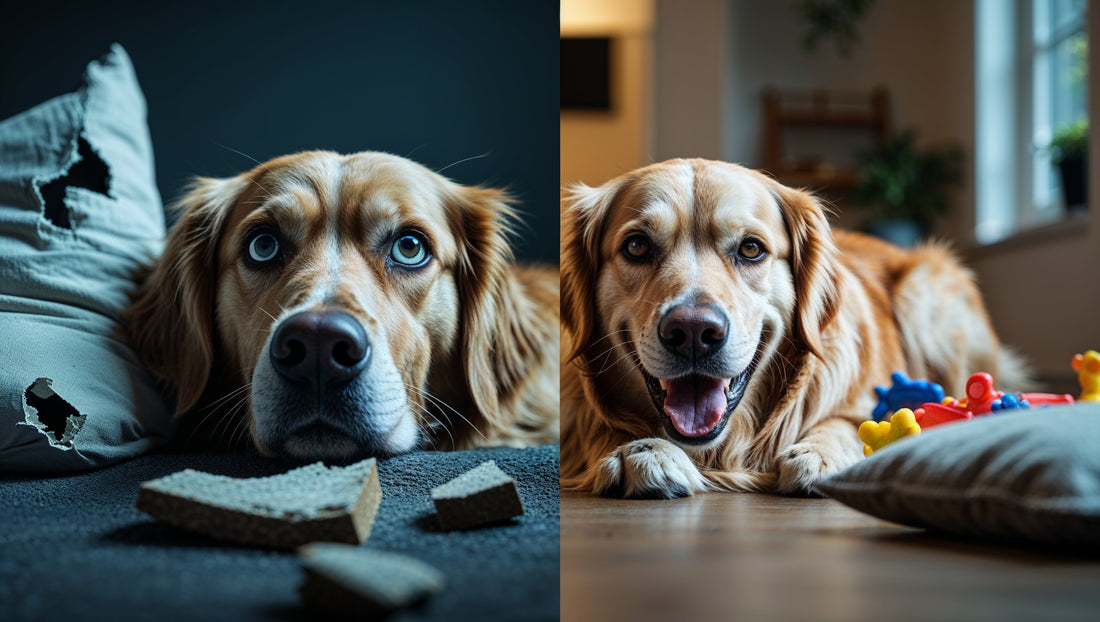If you've ever come home to destroyed furniture, neighbors complaining about barking, or a dog that seems to panic every time you grab your keys, you're not alone. Canine anxiety affects 72.5% of dogs according to a 2020 University of Helsinki study of 13,715 dogs—making it one of the most common behavioral issues pet parents face.
The heartbreaking truth? Most dogs suffer in silence because their humans don't recognize the signs. Unlike humans who can verbalize their feelings, our four-legged friends communicate distress through behavior that's often misunderstood as "being naughty" or "acting out."
But here's the good news: once you know what to look for, anxiety is highly treatable. Let's dive into the seven telltale signs your dog might be struggling with anxiety, and more importantly, what you can actually do about it.
The Hidden Signs Most Pet Parents Miss
1. Destructive Behavior When You're Gone
Coming home to a crime scene of shredded pillows isn't your dog being spiteful about you leaving. Dogs with separation anxiety often:
- Target items that smell like you (shoes, clothing, bedding)
- Destroy door frames and window sills trying to escape
- Only exhibit this behavior when alone
- Start destroying things within 15-30 minutes of your departure
The Science Behind It: When anxious, dogs' cortisol levels spike, triggering a fight-or-flight response. Chewing and destroying actually releases endorphins that temporarily calm them—it's literally self-medication through destruction.
2. Excessive Panting Without Physical Exercise
If your dog pants like they've run a marathon while lying on the couch, anxiety might be the culprit. Watch for:
- Panting in cool temperatures
- Heavy breathing during car rides
- Panting that starts during specific triggers (guests arriving, putting on your coat)
- Tongue that appears wider and flatter than normal exercise panting
What's Happening: Anxiety increases heart rate and body temperature, triggering panting as a cooling mechanism—even when they're not actually hot.
3. The "Velcro Dog" Syndrome
While we love our clingy companions, excessive attachment can signal anxiety:
- Following you to the bathroom every single time
- Panic when you close a door between you
- Inability to settle unless touching you
- Whining or scratching when separated by even a baby gate
Red Flag Alert: This behavior often escalates before developing into full-blown separation anxiety. Early intervention is crucial.
4. Inappropriate Elimination (Despite Being House-Trained)
Finding accidents from a fully house-trained dog is frustrating, but before you assume it's defiance, consider:
- Accidents only happen during specific triggers (storms, fireworks, being alone)
- Urination occurs in small amounts in multiple locations
- Defecation happens near exits (doors, windows)
- Your dog seems ashamed or hides after accidents
The Biology: Extreme stress can cause loss of bladder and bowel control—it's involuntary and your dog literally can't help it.
5. Obsessive Behaviors That Seem "Quirky"
What looks like funny personality traits might actually be anxiety manifesting as:
- Excessive licking of paws until raw
- Tail chasing that goes beyond playful
- Shadow or light chasing obsessively
- Repetitive barking at nothing
- Compulsive toy hoarding
Warning Sign: These behaviors often start small and escalate. Early intervention prevents them from becoming ingrained habits.
6. Changes in Body Language You Might Not Notice
Subtle physical signs often precede obvious anxiety symptoms:
- Whale eye (showing the whites of their eyes)
- Ears pinned back against head
- Tucked tail even during "normal" activities
- Excessive yawning when not tired
- Lip licking when no food is present
- Trembling or shaking
- Dilated pupils in normal lighting
Pro Tip: Video your dog when you're preparing to leave. Playing it back in slow motion reveals anxiety signs you miss in real-time.
7. Aggression That Seems "Out of Nowhere"
Fear-based aggression is often misunderstood:
- Snapping at other dogs during walks
- Resource guarding that's getting worse
- Growling at family members in specific situations
- Redirected aggression (attacking nearby objects/pets when triggered)
Critical Note: Aggression is often anxiety's last resort when other warnings are ignored. Never punish growling—it's communication, not defiance.
The Root Causes: Why Dogs Develop Anxiety
Understanding the 'why' helps you address the real problem, not just symptoms:
Genetic Predisposition
Certain breeds are anxiety-prone:
- Border Collies and Australian Shepherds (bred for vigilance)
- German Shepherds and Belgian Malinois (protective instincts)
- Cocker Spaniels and Pointers (separation anxiety tendencies)
- Rescue dogs with unknown histories
Early Life Experiences
- Puppies separated from mothers before 8 weeks
- Lack of socialization between 3-14 weeks old
- Traumatic events during fear periods (4-6 months, 14-18 months)
- Multiple rehoming experiences
Environmental Triggers
- Changes in routine or household
- Moving homes
- New family members (human or pet)
- Loss of a companion
- Aging and cognitive decline
Science-Backed Solutions That Actually Work
Forget the outdated advice about "showing dominance" or "letting them cry it out." Modern veterinary behavioral science offers proven solutions:
1. Counterconditioning and Desensitization
Transform negative associations into positive ones:
- Start with triggers at low intensity
- Pair with high-value rewards
- Gradually increase exposure
- Never force interactions
Success Story: Dogs with storm phobia showed 70% improvement using this method in a 2019 Penn State study.
2. Environmental Modifications
Create a calming sanctuary:
- Safe Space: Covered crate or quiet room with comfort items
- White Noise: Masks triggering sounds (Simple fan or sound machine)
- Pheromone Diffusers: Adaptil releases calming pheromones
- Anxiety Wraps: Gentle pressure provides comfort (like ThunderShirts)
- Interactive Toys: Mental stimulation reduces anxiety-driven behaviors
3. Exercise and Mental Enrichment
A tired dog is often a calmer dog:
- Minimum 30 minutes vigorous exercise daily
- Puzzle feeders for mental stimulation
- Sniff games engage natural instincts
- Training sessions build confidence
- Doggy daycare for social dogs
The Science: Exercise reduces cortisol and increases serotonin—nature's anti-anxiety medication.
4. Nutritional Support
Diet impacts mood more than you'd think:
- L-theanine and L-tryptophan: Amino acids promoting calmness
- Omega-3 fatty acids: Reduce inflammation linked to anxiety
- Probiotics: Gut health directly impacts mental health
- CBD oil: Showing promise in preliminary studies (consult your vet)
5. Professional Interventions
Sometimes you need expert help:
- Certified Animal Behaviorist: For complex cases
- Veterinary Examination: Rule out medical causes
- Prescription Medications: For severe cases (Fluoxetine, Clomipramine)
- Combination Therapy: Medication + behavior modification shows best results
The Path Forward: Your Action Plan
Helping an anxious dog requires patience, consistency, and sometimes professional help. Here's your roadmap:
Week 1-2: Observe and Document
- Record triggers, symptoms, and severity
- Video concerning behaviors
- Note patterns and timing
Week 3-4: Implement Basic Changes
- Create safe spaces
- Establish consistent routines
- Begin counterconditioning for mild triggers
- Add calming supplements (with vet approval)
Week 5-6: Evaluate Progress
- Compare behaviors to baseline
- Adjust strategies based on results
- Consult professionals if no improvement
Ongoing: Maintain and Adjust
- Continue successful interventions
- Gradually reduce management tools
- Build confidence through training
- Celebrate small victories
When to Seek Immediate Help
Some situations can't wait:
- Self-injury from anxiety behaviors
- Aggression escalating
- Complete inability to eat or drink when anxious
- Anxiety preventing normal daily functions
The Bottom Line: Hope for Anxious Dogs
Your anxious dog isn't broken, bad, or doing this on purpose. They're struggling with a legitimate medical condition that deserves compassion and proper treatment. With patience, the right approach, and sometimes professional help, even severely anxious dogs can learn to navigate their world with confidence.
Remember: addressing anxiety isn't about "fixing" your dog—it's about giving them tools to cope with a world that sometimes feels overwhelming. Every small step forward is a victory worth celebrating.
The journey might be long, but you're not walking it alone. Your dog is counting on you to recognize their struggles and advocate for their mental health. And based on the fact you're reading this? You're already on the right path.


